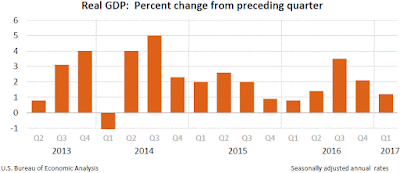Consumer Confidence Index (CCI) for May 2017
Predicted: 119.0
Actual: 117.9
The "predicted" figure is what economists were expecting, while the "actual" is the true or real figure.
From Today's Report:
"...'Consumer confidence decreased slightly in May, following a moderate decline in April,' said Lynn Franco, Director of Economic Indicators at The Conference Board. 'However, consumers’ assessment of present-day conditions held steady, suggesting little change in overall economic conditions. Looking ahead, consumers were somewhat less upbeat than in April, but overall remain optimistic that the economy will continue expanding into the summer months.'
Consumers’ appraisal of current conditions held steady in May. Those saying business conditions are 'good' edged down from 30.8 percent to 29.4 percent, but those saying business conditions are 'bad' was unchanged at 13.7 percent. Consumers’ assessment of the labor market also remained positive. Those stating jobs are 'plentiful' declined marginally from 30.3 percent to 29.9 percent, however, those claiming jobs are 'hard to get' decreased from 19.4 percent to 18.2 percent.
Consumers were less optimistic about the short-term outlook in May. The percentage of consumers expecting business conditions to improve over the next six months decreased from 25.1 percent to 21.3 percent, however, those expecting business conditions to worsen declined marginally from 10.4 percent to 10.1 percent.
Consumers’ outlook for the labor market was mixed. The proportion expecting more jobs in the months ahead declined from 21.9 percent to 18.6 percent, but those anticipating fewer jobs decreased from 13.8 percent to 12.0 percent. The percentage of consumers expecting their incomes to increase edged up from 18.7 percent to 19.2 percent, but the proportion expecting a decrease also rose, from 7.6 percent to 8.7 percent..."
Every month, The Conference Board sends a questionnaire to 5,000 U.S. households. Survey participants are polled about their feelings regarding the U.S. economy, current and future, and about their own fiscal circumstances. On average, 3,500 participants complete and return the 5-question survey.
The baseline "100" score for the CCI is associated with 1985 survey data.
When consumers feel good about the economy, they tend to do more spending, and vice versa.
Based in New York City, The Conference Board is a private, not-for-profit organization with a mission to, "create and disseminate knowledge about management and the marketplace to help businesses strengthen their performance and better serve society."
The CCI is usually released on the last Tuesday of the month.
Last month, the CCI was 119.4 (revised.)
Labels: cci, consumer_confidence, soft_data
|
--> www.FedPrimeRate.com Privacy Policy <--
CLICK HERE to JUMP to the TOP of THIS PAGE > SITEMAP < |










